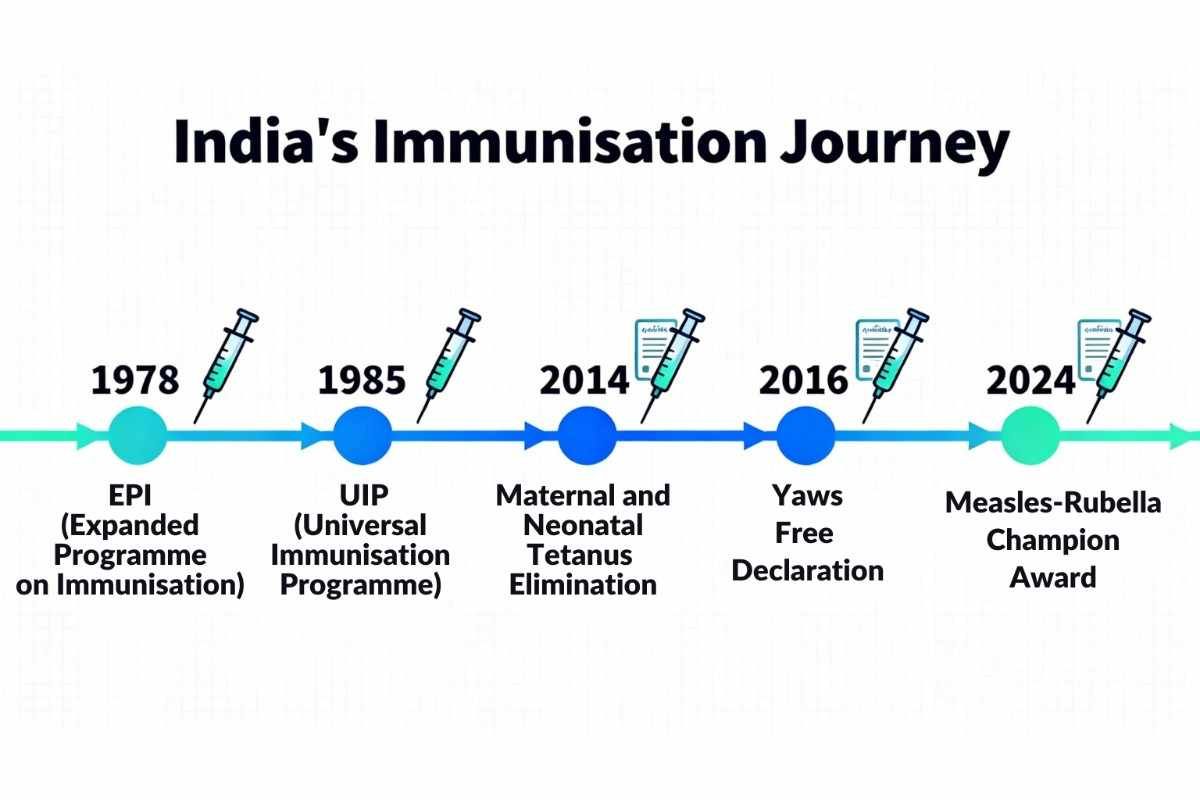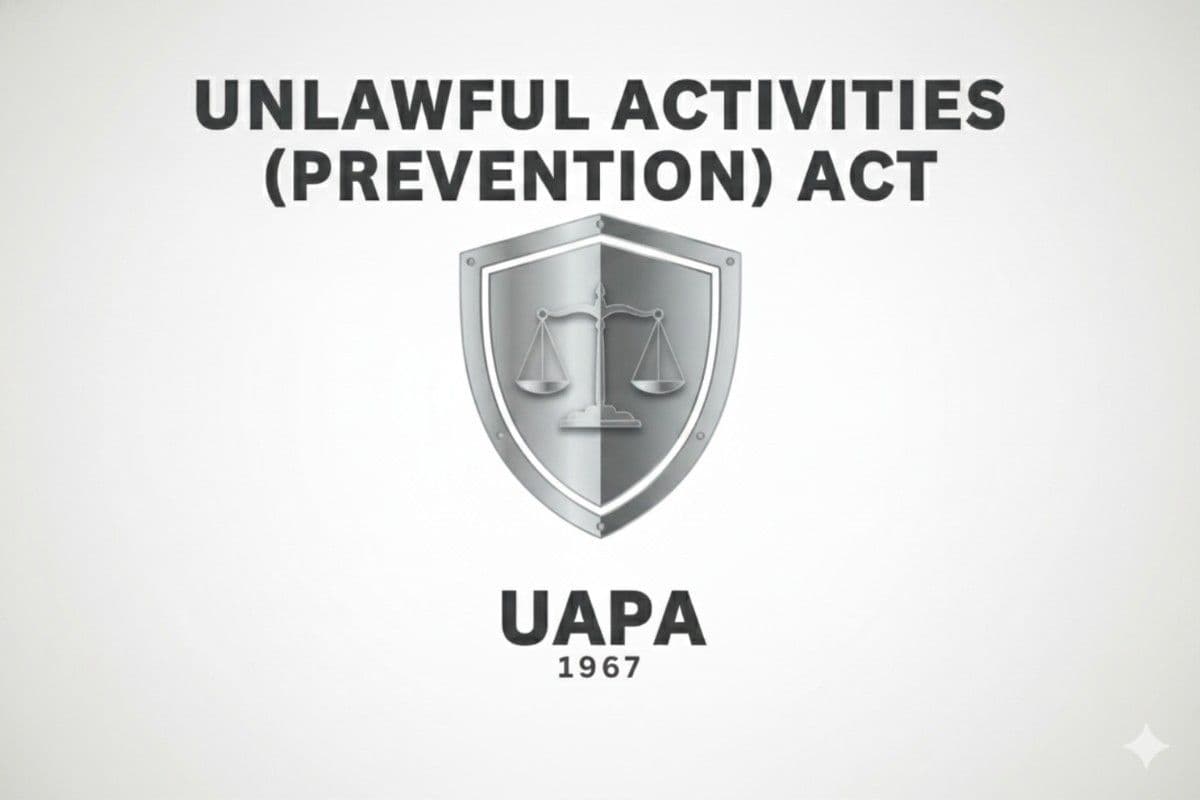World Immunisation Day 2025: Theme, Objectives, and India’s Immunisation Programmes for UPSC
Nov, 2025
•4 min read
Why in the News?
World Immunisation Day is celebrated on November 10 every year to remind countries and people about the power of vaccines. World Immunisation Week 2025 carries the theme "Immunisation for All is Humanly Possible."
Why Cover This Topic for UPSC?
- Relevant for UPSC Prelims & Current Affairs.
- Relevant for Mains GS Paper I & III (health policies, public health infrastructure, Vaccine development)
- Important for Essay and Interview discussions.
What is Immunisation?
Immunisation or Vaccination is a process where a weak or dead form of a disease-causing virus or bacteria (called a vaccine) is given to a person, usually through injection. This trains the body's immune system to recognise and fight the real disease if it ever enters the body.
It's like teaching your body's defence soldiers (immune system) to recognise and defeat an enemy (disease) before the actual battle happens.
Key Facts:
- Vaccines have saved at least 154 million lives in the last 50 years, which equals 6 lives saved every minute, every day, for 50 years.
- The measles vaccine alone accounts for 60% of all vaccine-related lives saved.
- Vaccination has reduced infant deaths by 40% and improved child survival more than ever before in history.
- Immunisation prevents 2 to 3 million deaths every year globally.

Why is World Immunisation Day Celebrated?
World Immunisation Day is celebrated to remind the world that vaccines are one of humanity's greatest achievements. It highlights the importance of vaccines in saving lives, preventing deadly diseases, and contributing to the development of healthier societies.
- Introduced by the WHO in 2012 to increase vaccination rates worldwide and achieve universal immunisation coverage.
- Marked annually on November 10 to raise awareness about vaccines and their vital role in preventing infectious diseases.
- Helps governments and individuals understand that vaccination is the most effective way to protect from deadly diseases.
- Celebrates the successful eradication of diseases (such as smallpox globally and polio in India).
- Encourages countries to turn "vaccines into vaccinations" through strong national programs.
Also read: National Cancer Awareness Day 2025
Objectives of World Immunisation Day
The main objective is to demonstrate that universal immunisation is achievable and save more lives through vaccines.
- Raise awareness about the life-saving power of vaccines and their role in preventing 12+ diseases.
- Demonstrate commitment to achieving 100% immunisation coverage for all children and pregnant women.
- Encourage governments to invest in strong immunisation programs at local and national levels.
- Believe it's possible to have less disease and more life through immunisation for all ages.
- Address vaccine hesitancy by providing accurate information and dispelling myths about vaccine safety.
- Protect vulnerable populations, including those in remote areas, urban slums, and migratory communities, with special immunisation campaigns.
Also read: International Day for Preventing the Exploitation of the Environment in War and Armed Conflict 2025
India's Role in Global Immunisation
India has emerged as a global leader in child immunisation, demonstrating how a large, diverse country can achieve massive vaccination success despite challenges.

1. India's Universal Immunisation Programme (UIP): The Universal Immunisation Programme (UIP) is India's backbone for vaccine delivery.
- Originally launched in 1978 as the Expanded Programme on Immunisation, it was renamed UIP in 1985 and expanded from urban to rural areas.
- Free vaccines against 12 diseases, including Diphtheria, Tetanus, Polio, Measles, Hepatitis B, Rotavirus, Pneumonia, and Japanese Encephalitis.
2. Mission Indradhanush: Mission Indradhanush was launched in December 2014 as a strategic initiative to increase immunisation coverage, particularly in underserved areas.
- Targets 554 districts that had low immunisation rates.
- Prioritises hard-to-reach regions, urban slums, and communities with vaccine hesitancy.
- Focuses on unvaccinated and partially vaccinated children in high-focus districts.
3. Zero Measles-Rubella Elimination Campaign: India launched a national campaign on April 23-24, 2025 (during World Immunisation Week) to eliminate measles and rubella by 2026.
- 100% immunisation coverage in all districts to achieve zero transmission of both diseases.
- Intensive vaccination drives in high-risk pockets (slums, remote areas, migrant clusters.
- Uses IDSP (Integrated Disease Surveillance Programme) and the U-WIN platform for real-time tracking.
4. U-WIN Digital Platform: The U-WIN (Unified Health Interface on Web for Immunisation at National Level) platform, launched nationwide in 2024, is revolutionising how India tracks vaccinations.
- Creates a digital registry of all immunisation events for pregnant women and children (0-5 years).
- Generates uniform QR-based e-vaccination certificates, accessible anytime by citizens.
- Provides automated SMS alerts about registration, doses administered, and upcoming reminders.
- Integrated with ABHA (Ayushman Bharat Health Account) for comprehensive health records.
5. Electronic Vaccine Intelligence Network (eVIN): India uses the eVIN platform for real-time vaccine stock management and cold chain monitoring.
- Monitors vaccine logistics across all cold chain points.
- Prevents vaccine wastage and stockouts.
- Integrated with Pradhan Mantri Ayushman Bharat Health Infrastructure Mission.
UPSC PYQ on Mission Indradhanush
QUESTION 1
Easy
'Mission Indradhanush' launched by the Government of India pertains to:
Select an option to attempt
Ongoing Challenges in India’s Immunisation Efforts
Despite major success, India continues to address key barriers:
- Remote and Tribal Populations: Geographic isolation in states like Uttar Pradesh, Bihar, and the Northeast areas.
- Vaccine Hesitancy: Misinformation, cultural beliefs, and anti-vaccine narratives in specific clusters.
- Access in Slums and Marginalised Areas: Urban slums and underserved regions have lower awareness and healthcare access.
- Migratory Populations: Mobile communities are harder to reach with routine services.
- Post-Pandemic Recovery: COVID-19 caused temporary immunity gaps, leading to localised measles outbreaks (2022-2024).
UPSC Mains Practice Question
How far do health initiatives like Mission Indradhanush contribute to India’s health indicators?
Evaluate Your Answers nowWay Forward
World Immunisation Day must drive action toward achieving universal vaccine access, closing immunity gaps, and building resilient health systems to ensure every person benefits from life-saving vaccines.
- Achieve Equity in Vaccine Access.
- Address Vaccine Hesitancy Globally.
- Strengthen Global Vaccine Supply Chains.
Unlock your UPSC success with SuperKalam!
Get instant doubt clearance, customised study plans, unlimited MCQ practice, and fast Mains answer evaluation.
Explore SuperKalam's resources and set yourself on the path to success!
Related Blogs

8th Pay Commission in India UPSC Notes: Objectives, Composition, NPS vs UPS
Nov, 2025
•4 min read

Constitution Day of India 2025: National Festival of Constitutional Values
Nov, 2025
•4 min read

Unlawful Activities (Prevention) Act, 1967 (UAPA): History, Provisions, Amendment | UPSC Notes
Nov, 2025
•4 min read